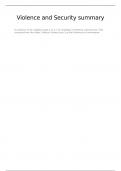Violence and Security summary
A summary of all readings (week 1 to 3 = 11 readings) of Violence and Security + Key
concepts from the slides. Politi cal Science year 2 at the University of Amsterdam.
,Inhoudsopgave
Tekst 1.1........................................................................................................................................................ 3
Organized violence 1989–2020, with a special emphasis on Syria...................................................................3
Key points and concepts slides (canvas)..............................................................................................................5
Text 2.1......................................................................................................................................................... 6
War Making and State Making as Organized Crime........................................................................................6
Text 2.2......................................................................................................................................................... 9
War and Economic Development: Export-Oriented Industrialization in East and Southeast Asia.....................9
Key points and concepts slides (canvas)............................................................................................................11
Text 3.1....................................................................................................................................................... 12
The Nuclear Taboo: The United States and the Normative Basis of Nuclear Non-Use....................................12
Text 3.2....................................................................................................................................................... 14
The New Era of Counterforce: Technological Change and the Future of Nuclear Deterrence..........................14
Key points and concepts slides (canvas)............................................................................................................15
Text 4.1....................................................................................................................................................... 17
The Flawed Logic of Democratic Peace Theory.............................................................................................. 17
4.2............................................................................................................................................................... 20
Democracy and Civil War: The Case of Colombia.......................................................................................... 20
Key points and concepts slides (canvas)............................................................................................................21
5.1............................................................................................................................................................... 22
Explaining Rape during Civil War: Cross-National Evidence (1980–2009).......................................................22
5.2............................................................................................................................................................... 24
Political Agency, Victimhood, and Gender in Contexts of Armed Conflict: Moving beyond Dichotomies........24
Key points and concepts slides (canvas)............................................................................................................25
Text 6.1....................................................................................................................................................... 26
Ethnic Nationalism and International Conflict: The Case of Serbia.................................................................26
Text 6.2....................................................................................................................................................... 28
Ethnic Conflict and Civil Society: India and Beyond.......................................................................................28
Key points and concepts slides (canvas)............................................................................................................29
2
, Tekst 1.1
Organized violence 1989–2020, with a special emphasis
on Syria
The document "Organized violence 1989–2020, with a special emphasis on Syria" provides a
comprehensive analysis of global trends in organized violence, focusing particularly on the
situation in Syria. The report uses data from the Uppsala Conflict Data Program (UCDP) to
present an overview of the state of violence in the world today.
Organized violence, a form of political violence, is discussed in the context of actions carried
out by organized groups such as states, non-state actors, and individuals who exercise one-
sided violence against civilians. The document categorizes organized violence into state-
based armed conflict, non-state conflict, and one-sided violence, using these categories to
analyze patterns and trends in global violence.
1. State-based armed conflict: This refers to conflicts involving a state and one or more
non-state actors, or between states. The article mentions that in 2020 there was a
record number of 56 state-bound armed conflicts worldwide. For example, the
border conflict between China and India, which had been inactive since 1967, saw
deadly skirmishes break out in 2020.
2. Non-state conflict: This refers to conflicts between two groups, neither of which is a
state, which can also lead to significant violence. The article cites the case of Mexico,
where the Jalisco Cartel New Generation has grown into one of the dominant
organizations, controlling various key areas and present in at least 27 of Mexico's 32
federal entities.
3. One-sided violence: This refers to situations where an actor, whether a state or a
non-state group, uses violence against civilians. The article notes that in 2020 there
was a record number of 39 actors who used one-sided violence, the highest number
since 2004.
These categories are used to analyze patterns and trends in global violence. For example, the
article notes that there has been a clear regional shift from the Middle East to Africa in terms
of organized violence over the past few years.
The report reveals a worrying increase in organized violence in 2020, breaking the trend of
decreasing deaths observed in the previous five years. In 2020, more than 80,100 deaths
were recorded, compared to 76,300 in 2019. This increase was largely due to escalating
conflicts in Artsakh (Nagorno-Karabakh), Azerbaijan, and Tigray, Ethiopia, which offset the
decrease in violence in Afghanistan and Syria.
The article also highlights a significant regional shift in organized violence from the Middle
East to Africa. In 2020, Africa experienced its bloodiest year since 2014, with 30 state-based
conflicts, including nine new or restarted. The number of active state-based and non-state
conflicts, as well as the number of actors exercising one-sided violence against civilians,
3




